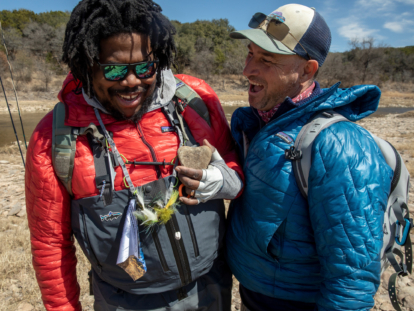Water Is Common Ground
Building community deep in the heart of Texas.
All photos by Andrew Burr
The cake is still warm, baked just an hour ago. It’s organic Madagascar vanilla—a two-layer beauty. I finish the frosting a few minutes before midnight, just as Jahmicah rolls up in front of the bungalow. We are set for an old-fashioned bell-to-bell hang, talking about life, spending time on the water and, most importantly, helping me understand his dream.
Five years ago, Jahmicah Dawes opened the first Black-owned outdoors store in the country, which is radical enough, but where he chose to put it is even more landmark.
“What, you baked a cake?! Are you kidding me?”
“Throw your gear in the side room. I’ll grab the forks.”
Loading fly rods and gear into the truck late the next day, we roll south for about an hour, from Houston toward the Gulf, to Galveston and one of the most surreal fly-fishing experiences I know.
The last light of the day slips away as the gloaming turns to night. The canoe, a dry bag and paddles are placed alongside the gunwales. I kick us off out into the bay. Everything has the gloriously heady smell of brine, oysters, shrimp, sandbars and spartina grass flats.
A native Texan, Jahmicah grew up in Wylie, a northeastern suburb of Dallas, which was somewhat rural back in 1986 when he was born. Thanks to its sweet onions and local agriculture, it used to be known as the “Onion Capital of the World.” In the early 1900s, cotton was the leading crop, and migrant laborers filled the town. His mother and father raised a couple boys and girls there and often took them to Dallas so they could visit museums, hear music and enjoy Lone Star culture. The family was tight-knit and loving—an infinite source of strength. Early experiences with the Boy Scouts, however, were far from inspiring. Jahmicah says he rarely felt like he fit in and was often the only Black kid around. Even today, the same pattern holds true when he is at any fishing event or outdoor show—and on the water. “I didn’t feel the outdoors was a safe space. There was no one like me,” he says. “One day a few years ago, I finally happened to see a story in a fly-fishing magazine on African American guide Alvin Dedeaux, and that was monumental for me. What a cool guy. If I can see it, I can be it.”
He went to Tarleton State University in Stephenville, Texas, to major in equine science but later shifted to fashion merchandising. He opened his own vintage store out of his dorm room while working at a sneaker shop, a skateboard shop and pursuing another passion—riding longboards anywhere he could find smooth, flowing concrete. He found jobs helping kids build character and stay away from drugs, and working with students in adaptive-behavior classes. All these components of his path point to his deep desire to serve others, helping them find their way in life and ultimately making a difference. Eventually, his experiences bloomed into his concept for an outdoor store called Slim Pickins Outfitters, which he opened in 2017 in his adopted hometown of Stephenville—although he’s now renamed it “Stephenchill.” The shop’s goal was to get everyone outside and provide a home and safe haven for the community.
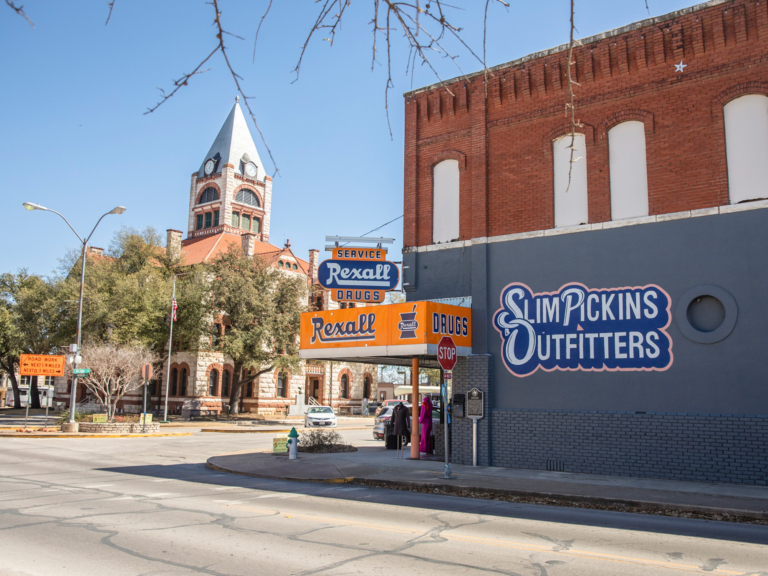
Slim Pickins Outfitters resides in downtown Stephenville, Texas, just a few yards from the county courthouse and its Confederate monument.
After 20 minutes of paddling under the vibey moon and passing clouds, we make our way to a series of canals fronted by expensive homes. Some of the homes have deployed bright green underwater lights. They attract plankton, which attracts baitfish, bringing out the redfish and speckled trout we hope to catch. A cold front has dropped the air pressure, so the fishing will be tough, but you can’t get anywhere in life without putting in the time and paying your dues. The mansions are beyond decadent. “Are these second homes without people living in them?” Jahmicah asks. “How much do these sell for?” “Oh, definitely millions of dollars,” I say, “but it’s free for us to paddle in here at night and catch all their fish!”
We don’t see much happening other than three fish swimming near one light a few feet down. A couple of dreamy and peaceful hours are filled with stories shared and no fish to be had. Just as we make our way out of the cove and the last of the fancy canal homes, I see a green light absolutely packed with stout redfish. They are riding high and looking for supper. I talk Jahmicah through what is about to happen. He hasn’t been fly fishing for very long, and in this type of situation, most people would probably come apart at the seams, rush it all, flail their cast and blow the shot.
Jahmicah lays out a sweetly composed 30-foot arc of line. It’s perfect. The lead redfish charges the streamer and completely whiffs, missing it and making a splash on the surface that causes all the fish to disappear.
On the ride home, Jahmicah is talkative. “That was such a crazy experience,” he says. “It was exciting and terrifying at the same time. You could read about something like this, see a film or a social media post, but that would always pale in contrast to the actual, lived experience. May I never stop getting excited about what being a fly angler has to offer.”
We get to the bungalow at about 1 a.m. I won’t deny that we rock the cake again before hitting the sack—it’s a short life and there can never be enough moments with cake and friends.
The next day we are up early for French press coffee with dollops of fresh cream and local honey. I hear happy children on the speakerphone as Jahmicah catches up with his two little ones, boys ages 1 and 4. I put a favorite reggae record on, and we sit at the breakfast table—the last of the cake beckoning. He shares how his father was originally from Jamaica and served in the Coast Guard and that the family has always loved being around the water.
I fill a thermos with the extra coffee, and we roll out toward an old-growth pine forest with a lake near central Texas. We stop for brisket and carnitas tacos and talk about how grateful we are to be here in the South with so much to explore. The fishing is still tough, but we find a couple largemouth bass on topwater deer hair frogs, and the day goes by too fast. We say goodbye with big bear hugs on the gravel road and make plans for me to visit the shop in Stephenville.
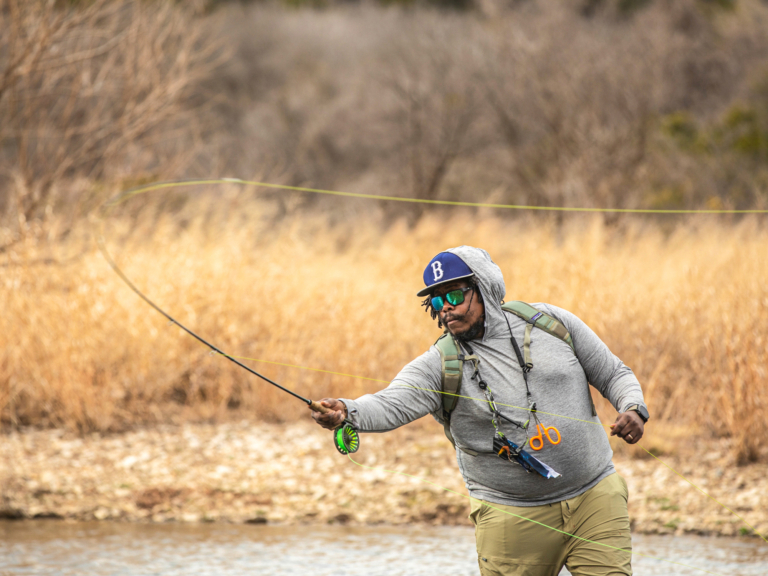
Texas state of mind. Jahmicah in the flow state.
What a beautiful light. Few people have it—Jahmicah sure does. After a 280-mile drive to central Texas, I see him step out of the Slim Pickins shop to greet me with his basset hound, Bill Murray. It’s perfect. Of all the outdoor outfitters staffed by the usual Labrador retrievers and pointers, he has a basset hound who holds court and is a legend in Stephenchill. I grab a longboard on one of the shelves and skate around the shop as fast as I can while Bill Murray chases me, nipping at my boot heels. The shop—a perfectly preserved Rexall drug store from decades ago—is an amalgamation of Jahmicah’s style, with vintage gear from the outdoors along the walls and a serious stash of vinyl records constantly spinning away.
Slim Pickins wants to be a haven for the community, but first it may have to create that community out of the dry air of central Texas. Before the pandemic, it held yoga nights and live music on Saturdays. It even formed “Outfitting the Saints,” a project to supply free gear to missionaries in the field all over the world. “This shop is bigger than me and this town,” Jahmicah says. “It’s far more for the global world.”
He is staking a claim here for future generations of all who love and need the outdoors. I marvel at the vintage drugstore fixtures and architecture, and Jahmicah asks, “I wonder if there was a time when I wasn’t allowed in these doors?”
Stephenville is a classic small Texas town. We walk out the front of the shop to roam, a chiropractic office, a kid’s dance center and an old bookstore nearby. I see a tall concrete monument directly across from the shop with a Confederate flag near the courthouse. I’m momentarily speechless. It was put there in 2001 to honor more than 600 Confederate veterans of the war between the states. We stand in front of it as Jahmicah reads the words aloud and shakes his head. “Racism affects all involved,” he says. “Those on the receiving end and those who commit it. It sends forth a negative energy to everyone.”
In 2007, social media photos of Tarleton University students went viral. A party on Martin Luther King Jr. Day showed some attendees portraying stereotypes of African Americans eating fried chicken, drinking malt liquor, dressed in afro wigs, faux gang apparel and toy guns. A female student was even dressed as Aunt Jemima. When the university had meetings regarding possible disciplinary actions, a chapter of the Klu Klux Klan came to campus, passed out flyers and held a march in downtown Stephenville.
I try to imagine that kind of all-encompassing hate. The crush of unfathomable anger behind judging a human by the color of their skin or heritage, but I can’t process it.
Inspiringly, there was a town march called “Justice for George/BLM” in Stephenville in June of 2020, with the police chief and a thousand other citizens of all races coming together arm in arm through the downtown streets. Jahmicah had participated in meetings that helped set things in motion. “You saw sons and daughters marching with their parents and having impactful conversations about the issues.”
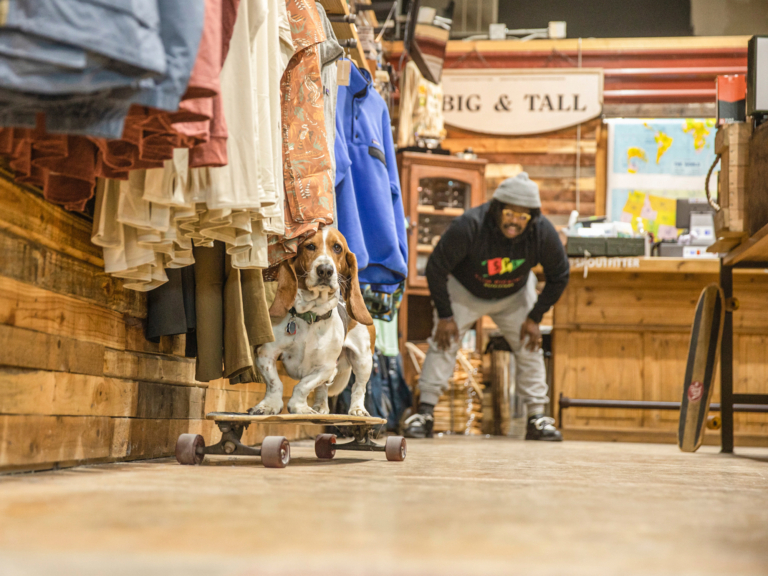
Bill Murray hangs 20 inside Slim Pickins Outfitters.
“This was not the money play. This was not a business decision. This, for us, was a quality-of-life decision. It’s a crapshoot. The risk is there, yet the people are the reward. ”
“Why would you put this shop here?” I ask him. “Why not Austin or Dallas or some hip town where it would do so well? It seems like you are up against so much. Can you even make it here?”
“I get asked that question all the time,” he says. “The verdict is still out on this. It’s obviously an experiment … We are not here to rake in money. The outdoor community, the fly-fishing community and our local community all lift us up. We get to really know people, say hello to them and care about them here. This was not the money play. This was not a business decision. This, for us, was a quality-of-life decision. It’s a crapshoot. The risk is there, yet the people are the reward. Our investment is to them. We see them in the grocery stores, the churches, the gas stations. They are our people, our friends. Yes, there have been some days I wonder if we are going to make it. We are transparent to a fault. There has been a day when the shop only made $12! It’s in those times that I really must trust I’ve been placed here for a reason. We want to grow where we are planted.”
In the outdoor world, multiculturalism is being celebrated. Still, I wonder who will walk the walk toward true positive change and who is simply checking the boxes. Jahmicah’s shop is here in Texas, where voting rights, women’s rights, transgender rights and issues of how race can be taught by educators are all under fire, and I’m deeply proud of him for choosing to create something special in Stephenville.
We make our way to Jahmicah’s house for a boisterous family supper. I’ve got the secret stash in the truck; another home-baked cake is on a travel platter as my contribution to the meal. Heather, Jahmicah’s wife, has made a family meatloaf recipe with a pitcher of fresh sweet tea to wash it down. We share endless giggles as I chase his two sons, Finis and Silas, around the house. Bill Murray even gets in on the fun, taking a flurry of tickles to the belly and running around like a furry freight train. “Heather is my game-changer,” Jahmicah tells me. “She steadfastly supports me as a dreamer and creative soul, and I knew she was the one for me back in college.”

Hook ’em horns! Jahmicah connects with an early-season bass.
Some of the sweetest feelings in fishing can come from just being on the cusp of doing it. On three hours of sleep, we drive 100 miles to a creek I’ve been eyeing. The weather is still funky thanks to another low-pressure system. I’m hoping the bass will be around, but conditions may be tricky. What I wouldn’t give for one fish. All that talk about how just being there is what matters is nice, but I want to catch ’em.
We paddle the canoe and work the banks with a favorite deer-hair frog fly. There are tree laydowns galore and heaps of structure, but the water still feels too cold for topwater. We make it all the way to the end of the winding creek, where it dead-ends in a grotto with stream-fed, emerald-green waters pouring in. I tell Jahmicah we may have to throw in the towel and turn around, but just after saying this, I see a stout largemouth bass finning deep in a cutbank.
Jahmicah casts a couple times to no avail, so I quickly tie on a wickedly vibrant crayfish pattern for one last shot. The fish flares its gills and charges from the logjam, inhaling the fly as we both howl with joy, “AWOOOOOHOOOOO!!!” Whooping it up as the fish comes alongside the canoe, there is palpable and blissful energy blooming in my ribcage. After releasing the fish, we relive the rowdy eat a few times, and our spirits are floating more than the canoe. On the lengthy paddle back, I see a tattered Confederate flag flying high from one of the homes on a bluff nearby and am stunned. “Yep, I saw that on the way in but didn’t say anything,” Jahmicah tells me.
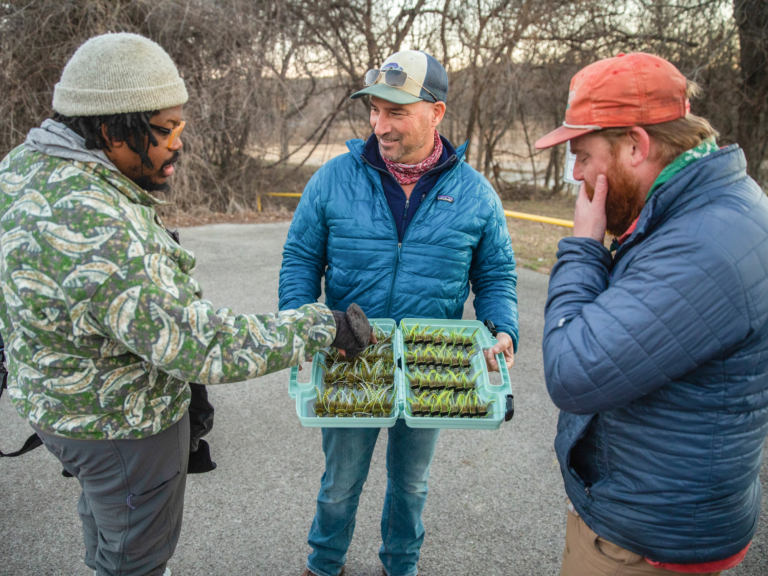
Bass bug bonanza. The author shares his home-tied, never-fail, deer-hair bass fly.
In 1960, John Graves wrote about the Brazos River in his book, Goodbye to a River. He made a three-week canoe voyage with his dachshund as a farewell since the area was under threat of proposed dams. “The world in which I grew up was Texan and Southern, and it had many, many failings,” he wrote as he floated down this river.
Ironically, for our last day together, Jahmicah and I are on the Brazos to fish thanks to rumors of stripers in the tailwater. We hike far down into a desert scrub canyon, and seeing the high rocky bluffs makes me wonder what it was like here when the river was wild. “Water is common ground,” Jahmicah tells me. “Where I can wash my woes away and reconnect or mend anything that may have broken. Plus, there is an intimacy with a fly line, that connection.”
We spend a few hours where nothing happens but amusing conversation, and then everything happens. Jahmicah gets schooled by a striped bass that blows up his 16-pound leader and gets away. He takes it all in stride with a bewildered grin. Soon after, I catch one on a chartreuse streamer. While jumping rocks and fighting it, I wipeout and float along the bank for a few seconds but hold on to the rod. It is a beautiful fish, with shoulders and heart. We admire the vivid stripes along the flanks and marvel at how amazing fish are as it glides effortlessly back to the river depths.
In the waning sunlight, we lean against mesquite trees and make plans to see each other again another day. Indigenous peoples in this area used boiled-down mesquite as a tonic. The flowers were used as medicinal teas. I think of how these trees quietly put down roots in areas with perceptible instability, unlikely that they could sustain life and even prosper. Yet they do.
“Sunshine and warm water seem to me to have full meaning only when they come after winter’s bite; green is not so green if it doesn’t follow the months of brown and gray,” observed John Graves.
Day by day, through passing thunderstorms that come along with the nurturing bluebird skies on the better days, the mesquite roots hold tight in a tenuous grasp to everything that matters and give back to the earth in unimaginably beautiful ways.

Jahmicah Dawes wet wades the best little bass stream in central Texas.
